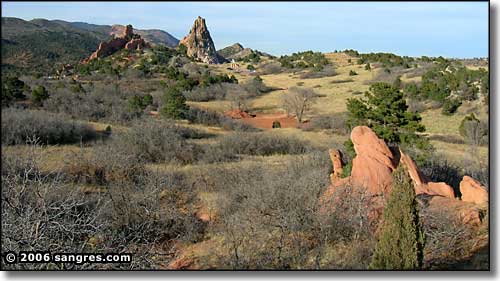
The Garden of the Gods is a Colorado Springs city park on the northwest side of the city. The land was given to the city in 1909 by the children of Charles Perkins, who had wanted to ensure that the park and its' formations would be open to the public forever. The park is justly famous for the manner in which these incredible fins and spires of Dakota Formation sandstone have been displayed for millenia and now, hopefully, preserved for future generations. Even in the very early days of the European migrations westward across America, folks realized that the majesty and sacredness of this incredible natural cathedral should be preserved. The encroachments of society have been kept pretty much at bay for over 150 years now, but the pressures and influence of the monied population are slowly making inroads into the park. The first time I came here (1965), Ridge Road didn't exist. The photo at the bottom of the next series of photos below this paragraph is looking from that direction but I wanted to show the rock and not the houses, which are somewhat hidden behind that rib of red sandstone in the upper left of the photo. Along Ridge Road you'll find homes built in between the fins and outcroppings of the red rock... Someone who donated a lot of money to build new infrastructure within the park got the "right" to develop a high-end neighborhood around the park somewhere and this might be the place...
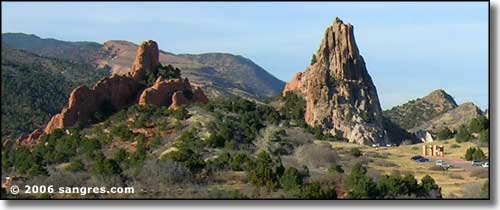
Closer to the heart of the park

North end of the park
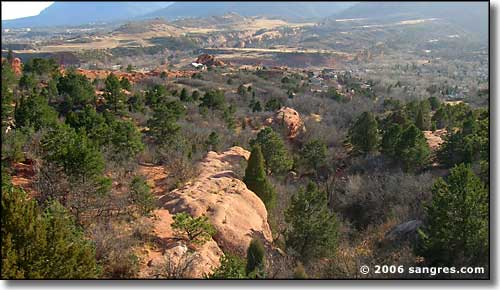
"Civilization" is slowly encroaching
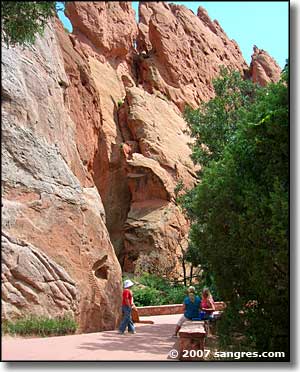
Anyway, these rock formations are composed of what the geologists call "Dakota sandstone." This sandstone was laid down hundreds of millions of years ago, long before there were any Rocky Mountains or Front Range. The sandstone was laid down in horizontal layers when this countryside was submerged under the ocean many times over the millenia. The granite that composes the Front Range (Pikes Peak, etc.) solidified underground some 1.8 billion years ago but was first pushed to the surface of the Earth about 65 million years ago in the cataclysms that caused the Ancestral Rockies to rise. (It's interesting that this timeline coincides with the comet strike in the Gulf of Mexico that is supposed to have wiped out the dinosaurs, but I have yet to see any official connection between the two massive, Earth-changing events. Instead, the geologists attribute the mountain-building to the crashing together of 2 tectonic plates along the West Coast, although there is also some major mention of an upwelling of magma from the Earth's core that is still going on in this area. It's this magma plume that later pushed up the fault-block mountains that we call Sangre de Cristo's and created the Spanish Peaks-Mt. Mestas-Silver Mountain complex with their also famous granite dikes.)
In that ancient granite being pushed to the surface, it broke through the layers of Dakota sandstone, uplifting and shifting them into vertical positions. The Garden of the Gods is one of the most spectacular remnants of this part of the mountain-building process that has gone on in the western half of North America. The actual line of exposed fins and spires runs from the Canadian border down to southern New Mexico with additional major exposed outcroppings at the Flatirons in Boulder, the Dakota Wall in the Cuchara Valley-Stonewall area, and the Garden of the Gods just north of Los Cerrillos on the Turquoise Trail, south of Santa Fe, New Mexico.
While the original Dakota formations were first turned up about 65 million years ago, additional mountain building 25-27 million years ago raised more large chunks of this hardened sandstone, especially along the eastern edge of the Sangre de Cristo Mountains.

The fence on the right blocks people from touching the older names carved in the sandstone
In wandering around, I came across areas where access to the rock was blocked and there were many signs all over speaking of areas under revegetation and recovery processes. There were also some signs asking folks to not scratch their names in the rock in such a way as to obscure names that were scratched in many years ago. A couple of signs were pretty blunt: If you do not have technical expertise and no climbing permit from the City of Colorado Springs, then stay on the sidewalk.
In the 40-some years that I have been visiting the Garden of the Gods, this is the first time that I have seen so much of the park so overgrown as to be unreachable. Areas where I saw weddings being performed 20 years ago are now completely lost in the underbrush. Old pathways have disappeared and new ones are concrete. There always used to be someone, somewhere scaling the higher faces nearly every time I went into the park. Not any more. And there weren't nearly the number of birds that I used to see... but the sensing of human population pressure... wait until you try to find a parking spot. The last few times I visited, I left by heading southwest and passing by Balanced Rock. It's been years since I've been lucky enough to come across a parking spot over there, that's why I have no pictures of that beautiful formation.
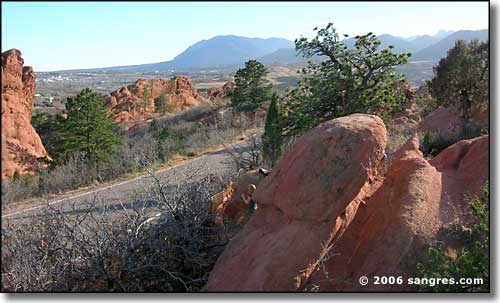
Ridge Road at the southern edge of the park
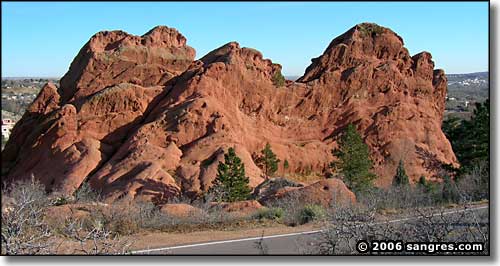
This outcropping is just north of the last of the houses on Ridge Road.

This is in that part of the park that most people are familiar with...

...as is this...

...and this.
